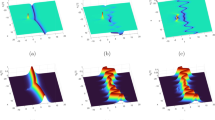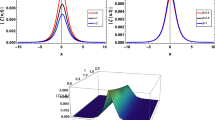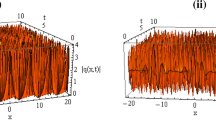Abstract
The main concern of this paper is to investigate the Hirota equation with variable coefficients that can describe the pulse propagation in inhomogeneous fibers more realistically than its constant coefficients counterparts. A variety of complex wave solutions including new exact solutions, bright and dark soliton solutions, and similarity solutions are retrieved through \(G'/G\)-expansion method with the aid of symbolic computation. The dynamical behaviors of the obtained solutions are illustrated using 3D- and corresponding contour plots in a graded-index waveguide.
Similar content being viewed by others
Avoid common mistakes on your manuscript.
1 Introduction
Optical solitons have been widely applied to long-distance communication and all-optical ultrafast switching devices after being proposed and confirmed experimentally by Hasegawa et al. [1] and Mollenauer et al. [2], respectively. So, it has attracted the concern of the research community in different fields of nonlinear optics [3,4,5,6]. The velocity, the amplitude, and the shape of the optical solitons cannot be affected in the propagation process due to the counterpoise between the self-phase modulation (SPM) effects and the group velocity dispersion (GVD) [7]. The well-known nonlinear Schrödinger (NLS) equation is regularly employed to represent pulse propagation in optical fibers and the propagation of picosecond optical solitons in monomode fibers [8]. In addition to the physical meaning of the NLS equation, many analytical solutions for this equation, such as the bright and dark solitons, have been explored in literature [9,10,11,12,13,14].
The main objective for our work is to study the following Hirota equation with variable coefficients [15]
where \(\Xi =\Xi (Z,T)\) is a complex function. Z represents the normalized propagation distance. T means the retarded time. \(\vartheta _2\) denotes the group velocity dispersion (GVD). \(\gamma\) indicates the Kerr nonlinearity. \(\vartheta _3(Z)\) represents the third-order dispersion (TOD). \(\tau (Z)\) describes the time delay related to the cubic term. \(\psi\) represents the external potential [16, 17]. Eq. (1) is the integrable form for the NLS equation and it can be utilized to describe the soliton interactions in inhomogeneous optical fibers (dispersion-flattened fibers). This kind of optical fiber makes long-distance transmission possible without the use of repeaters, and could potentially double transmission capacity as well [18]. Here, we discuss the effect of the TOD coefficient \(\vartheta _3(Z)\) on the structure of the soliton interactions. By choosing different values for \(\vartheta _3(Z)\) and the free parameters in the obtained solutions of Eq. (1), we will investigate the bound state of the soliton interactions which have potential applications in the formation of mode-locked fiber lasers and increase the transmission line bandwidth of optical communication systems. Liu et al. [19] derived the analytic three-soliton solutions for Eq. (1). However, we observe that exact solutions have not been studied much via the \(G'/G\)-expansion method and symbolic computation [20,21,22,23,24,25,26,27,28], which will become the main work of our paper. These analytical methods will be developed to deal with many of nonlinear complex partial differential equations with variable coefficients (Vc-NCPDEs). It is hoped that the obtained solutions can be used to enrich the dynamic behaviors for Vc-NCPDEs.
The organization of this paper is as follows. Section 2 presents the new exact solutions via the \((G'/G)\)-expansion method and symbolic computation, which contain dark soliton solutions. Section 3 gives the bright soliton solution, non-traveling wave solution, and periodic solution. Section 4 provides the similarity solutions. Section 5 gives the physical interpretation for some of the obtained solutions. The conclusion is investigated in Sect. 6.
2 Exact solutions
To seek the exact solutions of Eq. (1), we suppose
where \(\varrho =\Theta _1 T+\delta _1(Z)\) and \(\zeta =\Theta _2 T+\delta _2(Z)\) are real functions. \(\Theta _1\) and \(\Theta _2\) are unknown constants. \(\delta _1(Z)\) and \(\delta _2(Z)\) are unknown functions. Substituting Eq. (2) into Eq. (1) and separating the real and imaginary parts, we have
and
Integrating Eq. (4) with respect to \(\varrho\) once and by letting the integral constant to be zero, we get
Let the coefficients of Eqs. (3) and (5) satisfy the following proportional relation
From Eq. (6), we have the constraints
where \(\phi _1\) is integral constant. Substituting Eq. (7) into Eq. (3) (or Eq. 5), we have
Based on the idea of the \((G'/G)\)-expansion method [29,30,31,32,33,34,35], the solutions of Eq. (8) can be supposed as
where G satisfies the auxiliary equation
The solutions of Eq.(10) are given as
Substituting Eq. (9) along with Eq. (10) into Eq. (8) and equating all the coefficients of different powers of \([\frac{G'(\varrho )}{G(\varrho )}]^i (i=-3, \cdots , 3)\) to zero, we have
Case I
where \(\phi _2\) is integral constant, \(\epsilon _1=\pm 1\).
Case II
where \(\epsilon _2=\pm 1\).
Case III
where \(\epsilon _3=\pm 1\).
Case IV
where \(\epsilon _3=\pm 1\). By substituting Eq. (9) and Eq. (11) with the constraints (12), (13), (14), (15) into Eq. (2), respectively, an abundance of exact solutions for Eq. (1) can be obtained.
To show the properties and features of the obtained solutions, by substituting Eqs. (9), (11) and (12) into (2), we have
The absolute value for solution (16) with \(\lambda =-1, \mu =\phi _2=C_1=0, \vartheta _2=\Theta _2=C_2=\epsilon _1=1\), \(\gamma =2,\,\Theta _1=-3\), when \(\vartheta _3(Z)= -1\) a 3D plot. b Contour plot
The absolute value for solution (16) with \(\lambda =-1,\,\mu =\phi _2=0, \vartheta _2=\Theta _2=C_2=\epsilon _1=1\), \(\gamma =C_1=2,\,\Theta _1=-3\) when \(\vartheta _3(Z)= -Z\) a 3D plot. b Contour plot
The absolute value for solution (16) with \(\lambda =-1,\,\mu =\phi _2=0,\, \vartheta _2=\Theta _2=C_2=\epsilon _1=1\), \(\gamma =C_1=2,\,\Theta _1=-3\) when \(\vartheta _3(Z)= \cos Z\) a 3D plot. b Contour plot
or
The absolute value for solution (17) with \(\lambda =\phi _2=0, \mu =\vartheta _2=\Theta _2=C_2=\epsilon _1=1 ,\,\gamma =2\), \(\Theta _1=-3\) when \(\vartheta _3(Z)= -1\) in a, d; \(\vartheta _3(Z)= - Z\) in b, e and \(\vartheta _3(Z)= \cos Z\) in c, f
When \(\vartheta _3(Z)= -1\), the dynamical behaviors of solution (16) are demonstrated in Fig. 1. Figure 1 describes the propagation of dark soliton solution. When \(\vartheta _3(Z)=- Z\), the dynamical behaviors of solution (16) are shown in Fig. 2. Figure 2 describes the propagation of non-traveling wave solution. When \(\vartheta _3(Z)=\cos Z\), the dynamical behaviors of solution (16) are displayed in Fig. 3. Figure 3 shows the propagation of periodic solution. The dynamical behaviors of solution (17) are shown in Fig. 4 with \(\vartheta _3(Z)= -1\), \(\vartheta _3(Z)= -Z\) and \(\vartheta _3(Z)= \cos Z\), respectively.
3 Bright soliton solutions
This section is devoted to finding the bright soliton solutions.
To this end, we assume that
Substituting Eq. (18) into Eq. (8), we obtain
where \(\epsilon _4=\pm 1\). Substituting Eqs. (7), (18) and (19) into (2), the bright soliton solutions for Eq. (1) are written as
The dynamical behaviors for bright soliton solutions (20) with the different values of \(\vartheta _3(Z)\) are described via Fig. 5.
The absolute value for solution (20) with \(\vartheta _2=-1,\, \Theta _2=\gamma =\epsilon _4=1,\, \phi _2=0,\,\Theta _1=2\) when \(\vartheta _3(Z)= -1\) in a, d, \(\vartheta _3(Z)=1+ Z\) in b, e, and \(\vartheta _3(Z)= \cos Z\) in c, f
4 Similarity solutions
In Eq. (8), by assuming that
where \(\epsilon _ 5=\pm 1\), Eq. (8) becomes
The elliptic functions solutions for Eq. (22) have been discussed in Ref. [36]. Substituting the elliptic functions solutions for Eqs. (22) into (2), the corresponding similarity solutions for Eq. (1) can be obtained.
5 Physical interpretation for soliton interactions
In this part, discussions and physical interpretation for some of the obtained solutions will be demonstrated.
Figures 1, 2, 3 show different types of backgrounds for the dark solitons solution given by Eq. (16) in T–Z plane. It can be seen that the propagation trajectories of the dark solitons projected onto T–Z plane are straight lines, a parabolic type, and a periodic type when \(\vartheta _3(Z)=-1\), \(\vartheta _3(Z)=-Z\), and \(\vartheta _3(Z)=\cos Z\), respectively. Figure 1 depicts a transmission of the dark soliton with the invariant amplitude (without any gain or loss) in inhomogeneous optical fiber. Due to the inhomogeneous coefficient \(\vartheta _3(Z)=-Z\) in Fig. 2, the dark soliton propagates along a parabolic-type trajectory on the surface of a monotonically decreasing background. While in Fig. 3, the background undergoes a periodic oscillation due to inhomogeneous coefficient \(\vartheta _3(Z)=\cos Z\). With the previous results, we may provide a possible way to control the propagation of the dark solitons in the inhomogeneous optical fibers regime by choosing suitable values for the inhomogeneous TOD and the free parameters in the obtained solutions. Figure 4 introduces the solitons solution given by Eq. (17), which is singular solution, in T–Z plane. It is clear that the intensity of this solution gets stronger and consequently it is not stable.
Figure 5 represents different types of backgrounds for the bright solitons solution given by Eq. (20) in T–Z plane. The same discussion as in Figs. 1, 2, 3 can be introduced for this solution.
6 Conclusion
In the current investigation, an attempt was adopted to study the Hirota equation with variable coefficients, which describes soliton interactions in inhomogeneous optical fibers. The \(G'/G\)-expansion method was successfully exerted to acquire a bunch of different wave solutions including exact solutions, bright and dark soliton solutions, and similarity solutions. We found interesting behaviors, depending on the values of the free variable coefficients in the obtained solutions which are shown in Figs. 1, 2, 3, 4, 5. The results of this work come with a lot of encouragement for further future discussion in different branches of science, especially in nonlinear optics.
References
A. Hasegawa, F. Tappert, Transmission of stationary nonlinear optical pulses in dispersive dielectric fibers. I. Anomalous dispersion. Appl. Phys. Lett. 23(3), 142–144 (1973)
L.F. Mollenauer, R.H. Stolen, J.P. Gordon, Experimental observation of picosecond pulse narrowing and solitons in optical fibers. Phys. Rev. Lett. 45, 1095–1097 (1980)
A. Hasegawa, Y. Kodama, Solitons in Optical Communications (Oxford University Press, Oxford, 1995)
H.Q. Zhang, Y. Wang, N–dark–dark solitons for the coupled higher-order nonlinear Schrödinger equations in optical fibers. Mod. Phys. Lett. B 31(33), 1750305 (2017)
A.R. Seadawy, D. Lu, Bright and dark solitary wave soliton solutions for the generalized higher order nonlinear schrödinger equation and its stability. Results Phys. 7, 43–48 (2017)
W. Liu, M. Liu, J. Yin, H. Chen, W. Lu, S. Fang et al., Tungsten diselenide for all-fiber lasers with the chemical vapor deposition method. Nanoscale 10(17), 7971–7977 (2018)
M.S. Osman, J.A.T. Machado, D. Baleanu, On nonautonomous complex wave solutions described by the coupled Schrödinger-Boussinesq equation with variable-coefficients. Opt. Quant. Electron. 50(2), 73 (2018)
M.S. Osman, A. Korkmazc, H. Rezazadeh, M. Mirzazadeh, M. Eslami, Q. Zhou, The unified method for conformable time fractional Schrödinger equation with perturbation terms. Chin. J. Phys. 56(5), 2500–2506 (2018)
G.F. Yu, Z.W. Xu, J. Hu, H.Q. Zhao, Bright and dark soliton solutions to the AB system and its multi-component generalization. Commun. Nonlinear Sci. 47, 178–189 (2017)
E.M.E. Zayed, A.G. Al-Nowehy, The solitary wave ansatz method for finding the exact bright and dark soliton solutions of two nonlinear schrödinger equations. Assoc. Arab Univ. Basic Appl. Sci. 24, 184–190 (2016)
C.Q. Dai, Y. Fan, Y.Y. Wang, J. Zheng, Chirped bright and dark solitons of (3 + 1)-dimensional coupled nonlinear schrödinger equations in negative-index metamaterials with both electric and magnetic nonlinearity of kerr type. Eur. Phys. J. Plus 133(2), 47 (2018)
J.J. Su, Y.T. Gao, N th-order bright and dark solitons for the higher-order nonlinear schrödinger equation in an optical fiber. Superlattices Microstruct. 120, 697–719 (2018)
Y.Q. Yuan, B. Tian, L. Liu, H.P. Chai, Bright-dark and dark-dark solitons for the coupled cubic-quintic nonlinear schrödinger equations in a twin-core nonlinear optical fiber. Superlattices Microstruct. 111, 134–145 (2017)
Y.J. Xu, Bright and dark optical vortex solitons of (3 + 1)-dimensional spatially modulated quintic nonlinear schrödinger equationm. Optik 147, 1–5 (2017)
Y. Yao, Y. Huang, High-order rogue-wave of the inhomogeneous nonlinear Hirota equation with a self-consistent source. Mod. Phys. Lett. B 33(8), 1950087 (2019)
J.M. Soto-Crespo, Nail Akhmediev, Ph Grelu, F. Belhache, Quantized separations of phase-locked soliton pairs in fiber lasers. Opt. Lett. 28, 1757–1759 (2003)
M. Haelterman, A. Sheppard, Bifurcation phenomena and multiple soliton-bound states in isotropic Kerr media. Phys. Rev. E 49, 3376–3381 (1994)
T.P. Pittman, D.V. Strekalov, D.N. Klyshko, M.H. Rubin, A.V. Sergienko, Y.H. Shih, Two-photon geometric optics. Phys. Rev. A 53(4), 2804 (1996)
W. Liu, C. Yang, M. Liu, W. Yu, Y. Zhang, M. Lei, Effect of high-order dispersion on three-soliton interactions for the variable-coefficients Hirota equation. Phys. Rev. E 96, 042201 (2017)
J.G. Liu, M.S. Osman, A.M. Wazwaz, A variety of nonautonomous complex wave solutions for the (2+ 1)-dimensional nonlinear Schrödinger equation with variable coefficients in nonlinear optical fibers. Optik 180, 917–923 (2019)
L.N. Gao, Y.Y. Zi, Y.H. Yin, W.X. Ma, X. Lü, Bäcklund transformation, multiple wave solutions and lump solutions to a (3 + 1)-dimensional nonlinear evolution equation. Nonlinear Dyn. 89, 2233–2240 (2017)
H.Q. Zhang, S.S. Yuan, Dark soliton solutions of the defocusing Hirota equation by the binary Darboux transformation. Nonlinear Dyn. 89, 531–538 (2017)
H.Q. Zhang, S.S. Yuan, General N-dark vector soliton solution for multi-component defocusing Hirota system in optical fiber media. Commun. Nonlinear Sci. Numer. Simulat. 51, 124–132 (2017)
Y.H. Yin, W.X. Ma, J.G. Liu, X. Lü, Diversity of exact solutions to a (3+1)-dimensional nonlinear evolution equation and its reduction. Comput. Math. Appl. 76, 1275–1283 (2018)
M. Younis, S.T.R. Rizvi, Q. Zhou, A. Biswas, M. Belic, Optical solitons in dual-core fibers with G’/G-expansion scheme. J. Optoelectron. Adv. M. 17(3–4), 505–510 (2015)
H.Q. Zhang, Y. Wang, Multi-dark soliton solutions for the higher-order nonlinear Schrödinger equation in optical fibers. Nonlinear Dyn. 91, 1921–1930 (2018)
H.Q. Zhang, J. Chen, Rogue wave solutions for the higher-order nonlinear Schrödinger equation with variable coefficients by generalized Darboux transformation. Mod. Phys. Lett. B 30(10), 1650106 (2016)
X. Liu, Exact travelling wave solutions for nonlinear schrödinger equation with variable coefficients. J. Appl. Anal. Comput. 7, 1586–1597 (2017)
W.J. Liu, Y.J. Zhang, H. Triki, M. Mirzazadeh, M. Ekici, Q. Zhou, A. Biswas, M. Belic, Interaction properties of solitonics in inhomogeneous optical fibers. Noninear Dyn. 95(1), 557–563 (2019)
Y.J. Zhang, C.Y. Yang, W.T. Yu, M. Mirzazadeh, Q. Zhou, W.J. Liu, Interactions of vector anti-dark solitons for the coupled nonlinear Schrödinger equation in inhomogeneous fibers. Nonlinear Dyn. 94(2), 1351–1360 (2018)
Q. Zhou, M. Ekici, A. Sonmezoglu, M. Mirzazadeh, M. Eslami, Optical solitons with Biswas-Milovic equation by extended trial equation method. Nonlinear Dyn. 84(4), 1883–1900 (2016)
E.M.E. Zayed, R.M.A. Shohib, Solitons and other solutions to the improved perturbed nonlinear schrödinger equation with the dual-power law nonlinearity using different techniques. Optik 171, 27–43 (2018)
A. Biswas, M. Ekici, A. Sonmezoglu, M. Belic, Chirped and chirp-free optical solitons with generalized anti-cubic nonlinearity by extended trial function scheme. Optik 178, 636–644 (2019)
M. Ekici, A. Sonmezoglu, Optical solitons with Biswas-Arshed equation by extended trial function method. Optik 177, 13–20 (2019)
A. Biswas, A. Sonmezoglu, M. Ekici, M. Mirzazadeh, Q. Zhou, A.S. Alshomrani, S.P. Moshokoa, M. Belic, Optical soliton perturbation with fractional temporal evolution by extended \((G^{\prime }/G)\)-expansion method. Optik 161, 301–320 (2018)
P.A. Clarkson, New similarity solutions for the modified boussinesq equation. J. Phys. A. 22(13), 2355–2367 (1999)
Author information
Authors and Affiliations
Corresponding authors
Rights and permissions
About this article
Cite this article
Liu, JG., Osman, M.S., Zhu, WH. et al. Different complex wave structures described by the Hirota equation with variable coefficients in inhomogeneous optical fibers. Appl. Phys. B 125, 175 (2019). https://doi.org/10.1007/s00340-019-7287-8
Received:
Accepted:
Published:
DOI: https://doi.org/10.1007/s00340-019-7287-8









